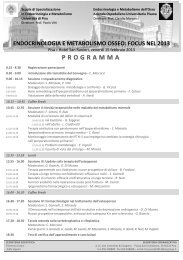You also want an ePaper? Increase the reach of your titles
YUMPU automatically turns print PDFs into web optimized ePapers that Google loves.
The concept of harmony (187 a-e) and its cosmological role in Eryximachus’<br />
discourse<br />
Introduction<br />
Laura Candiotto<br />
This article aims to analyze the role of harmony specifically in the <strong>Symposium</strong> 187a-e and, more<br />
generally, in Eryximachus’ discourse. In opposition to those who consider Eryximachus a pedant 1 ,<br />
whose discourse is refuted by Diotima’s discourse 2 , the paper proposes an interpretation emphasizing<br />
literary and philosophical aspects which enable us to grasp the positive significance carried by<br />
Eryximachus’ discourse within the <strong>Symposium</strong> 3 .<br />
After having analyzed Eryximachus’ character and its role in the dialogue, the concept of<br />
“harmony” will be explored in relation to pre-Socratic physics and Hippocratic medicine. The aim of<br />
this article is to evaluate the philosophical import of a “cosmological medicine”, emphasizing how<br />
this concept recurs also in other dialogues, and to present reasons for considering it as an expression<br />
of platonic philosophy.<br />
Eryximachus and the medicine of IV Century<br />
Eryximachus 4 is a physikos belonging to a family of doctors 5 (his father is Acumenus) whose<br />
members trace their origin back to Asclepius. As a platonic character, we find him – in addition to the<br />
<strong>Symposium</strong> – in Protagoras 315c, where he questions Hippias about nature, astronomy and<br />
meteorology. Moreover, he is cited in Phaedrus 268a as Phaedrus’s friend 6 . In these three occasions<br />
he is presented as a friend of Phaedrus, so his relationship with him developed at least from 433/432<br />
BC, dramatic dating of Protagoras, to 416 BC, dramatic dating of the <strong>Symposium</strong>. One Eryximachus<br />
is cited among those who desecrate the Herms in 415, but it is not clear whether or not he is the<br />
Eryximachus we are referring to.<br />
Eryximachus represents temperance or – we could say on the basis of what will be<br />
demonstrated below – the concept of harmony: as a symposiarch he decides a correct balance to the<br />
proportions of water and wine 7 , as a doctor he proposes a therapy for Aristophanes’ hiccups 8 , as a<br />
good musician he establishes the order of discourses and restores it after the disorder generated by<br />
Alcibiades’ arrival 9 . The characterization of Eryximachus reflects thus the content conveyed by his<br />
encomium of Eros and by his prominent position in the dialogue 10 . Arguably, grasping these aspects<br />
enables us to question, at least partially, the assumption that Eryximachus’ discourse is pedantic and<br />
sophistic.<br />
Plato intervened with a discourse of this type in the debate 11 concerning the relation between<br />
philosophy and medicine, which develops in the fifth Century due to the establishment of Hippocratic<br />
medicine 12 . In the discourse of Eryximachus, Plato places himself between Empedocles and the Ionics<br />
on the one hand and Hippocrates on the other 13 . The discourse is thought also as a response to<br />
Eleatism and Heraclitism in relation to the nature of the compounds.<br />
The Cosmological role of harmony<br />
We are going to highlight now the aspects of closeness and distance between Eryximachus’ discourse<br />
and each of these positions, in particular in relation to the cosmological role of harmony, to the<br />
1<br />
Bury 1909, Robin 1929, Dover 1980, Rosen 1987, Nehamas 1989.<br />
2<br />
For example Corrigan 2004.<br />
3<br />
In line with Edlestein 1945, Konstan, Young-Bruehl 1982, Rowe 1999, Hunter 2004, McPerrhan 2006, Cooksey 2010.<br />
4<br />
Nails 2002.<br />
5<br />
Plat., Symp. 214b.<br />
6<br />
Cf. also Plat., Symp. 177a.<br />
7<br />
Plat., Symp.176b, 214b.<br />
8<br />
Plat., Symp. 185c7-8.<br />
9<br />
Plat. Symp. 223b.<br />
10<br />
In agreement with what has been demonstrated by Edelstein 1945, in particular cf. p. 99.<br />
11<br />
Cambiano 1991, Longrigg 1993, Vegetti 1995.<br />
12 Edelstein 1945.<br />
13 Jouanna 1961.




